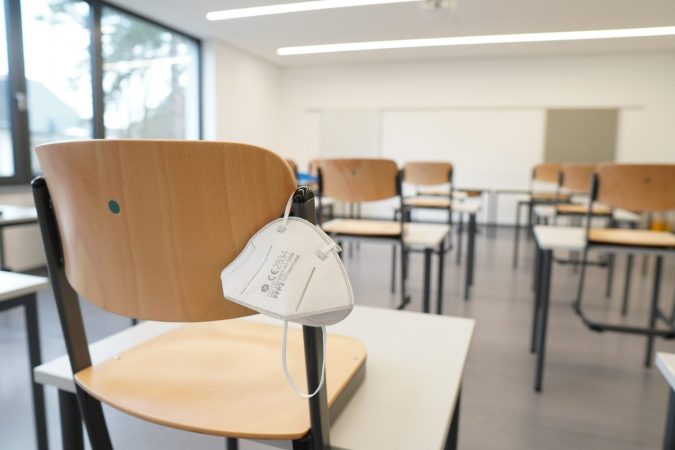There is something magical and freeing about a snow day as a kid. The sight of snowflakes falling outside the window before bed and the task of waking up extra early to listen to the radio’s listing of what schools were closed that day was simply thrilling. It was out of the ordinary, so special! The truth is, however, for many Detroit students, the idea of missing a day of school isn’t a novelty, like a snow day, nor does it provide a sense of freedom.
Prior to the COVID-19 pandemic, over half of Detroit students were chronically absent from school, meaning 10% of the school year was missed. This rate has only gotten worse on average during the past year due to the pandemic, but the causes were widely unknown. Detroit Education Research Partnership (DERP), in an effort to deeper, understand this problem and find solutions, conducted interviews with parents and students in the Detroit school system.
During DERP’s research and interviews, it was found that most parents and students understand the long-term effects of chronic absenteeism, and truly care about good attendance. According to Sarah Lenhoff, the Assistant Professor of Educational Leadership & Policy Studies at Wayne State University and Director of DERP, “The vast majority of them [students]… want to be in school and just have real barriers to getting there.” So why then is Detroit’s chronic absence rate so high?
As their research and interviews continued, DERP soon found a pattern. The two main inhibitors for students and school attendance are transportation and health.
TRANSPORTATION
In DERP’s report, it states that before the pandemic began, “More than a third of Detroit families did not own a car, and most lived too far from school to walk,” and many students live outside of school bus routes. Detroit is still suffering from increasing financial insecurity and high unemployment rates due to the pandemic which will likely lead students towards a greater lack of transportation post-pandemic.

SARAH LENHOFF; DIRECTOR OF DERP ASSISTANT PROFESSOR OF EDUCATIONAL LEADERSHIP AND POLICY STUDIES
Many families that did have a vehicle, DERP found, only owned one and/or it was unreliable. In situations like these, DERP’s report says that parents had to find other transportation for their children. Some families utilized public transit, rideshare services, and asked friends and family for transportation. But due to noncoordinating transit and school schedules, the expense of rideshares, and social distancing guidelines, none of these solutions have proven to be greatly effective, long-term.
The question stands then, what are solutions that can implement change on a long-term basis? DERP offers multiple solutions, ranging from immediate to long-term implementation times for lasting effects. These solutions can include a combination of coordinating public transportation for Detroit students’ schedules, backup transportation offered through the school system (such as vans or carpools), and a more in-depth look at choice school systems.
To Lenhoff, choice education does not greatly help Detroit students to receive better education for a number of reasons. “I don’t think it’s true that choice has increased integration,” Lenhoff says. When the ability to choose what school a child could attend was granted to Detroit families, the school system looked entirely different. Then there were more neighborhood schools and now schools are farther apart, becoming less accessible by Detroit students and their families.
Lenhoff offers up the example of Mayor Mike Duggan’s plan for Twenty-Minute Neighborhoods throughout Detroit. This concept is described as a neighborhood in which the residents are no more than a 20-minute walk from retail stores, transit access, and a park or greenway, and that residents do not come in contact with blight within that radius. “Why wouldn’t we think about putting schools in that equation?” Lenhoff asks, “Why shouldn’t we have a school be within a… walking distance from most families in Detroit?”
Of course, families could still choose to send their child to a different school, but reintegrating a more widespread system maY just be what Detroit is in need of.
HEALTH
DERP’s report found that secondary to transportation, Detroit students and parents equated absences to health. “In addition, when students have chronic health issues (e.g., diabetes, severe asthma, or allergies) that are under-treated or very severe, they are the main driver of chronic absence,” the report states. Families also reported health as an issue in the capacity of a student’s mental health or their parent’s health affecting their ability to provide transportation for the student.
Many Detroit students noted they had absences from school so they could attend a health care session (doctor’s appointment, dentist appointment, therapy, counseling) that could not be scheduled outside of school hours. Parents, along with this, stated there weren’t clear boundaries (prior to the pandemic) for what level of sickness a child should be measured by to keep them home from school.
Due to the COVID-19 pandemic, these situations have been exacerbated. DERP found that many parents and students are “skeptical about the efficacy of a COVID-19 vaccine, perceive others as unwilling to take the vaccine, or refuse to take the vaccine themselves,” all mindsets of which create issues with in-person classes at this time.
DERP again offers solutions in immediate to long-term solutions. The immediate solution is for schools to provide guidance and clear boundaries, current and post-pandemic, for parents and students to follow with their student’s health. Hand in hand with this is the offering of PPE for students as they return to in-person classes.
The long-term solutions they offer revolve around contingency plans and health promotion for students, teachers, and parents. Schools should find ways to work with and provide education for chronically ill students who have to miss multiple days of school due to their health. There can also be reconsideration and a greater understanding of the importance of physical and mental health for youth with the inclusion of health practices through the school system.
Chronic absenteeism isn’t a new topic, especially in urban cities with high African American populations like Detroit that struggle consistently with racial inequities. Partnerships like DERP and individuals like Lenhoff continually work for better education that is equal, equitable, accessible, and good for our students. And maybe someday soon, with the application of the solutions found in this report, the novelty of a snow-day can be felt city-wide by Detroit students.
Subscribe to our newsletter for regular updates on all things Detroit and more.




















